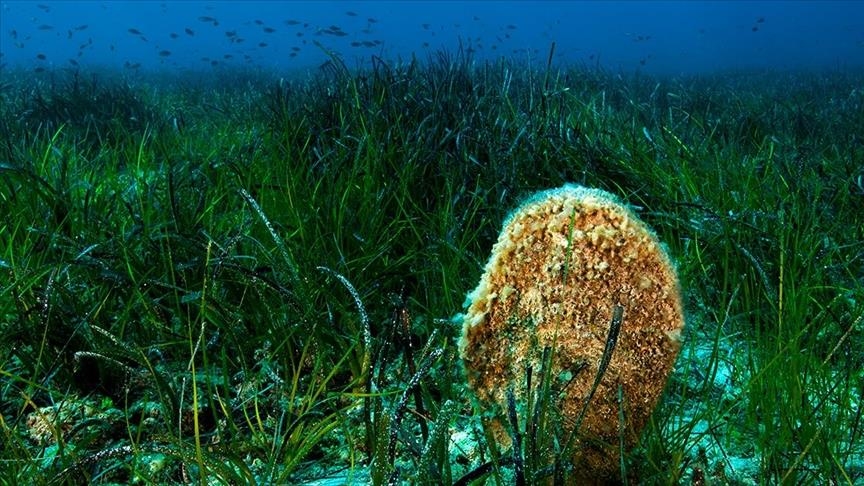'Lungs of the seas' under severe threats
'Rainforests can store 1.7 pounds of carbon, while seagrasses 10 times more than rainforests'

ISTANBUL
Seagrass meadows, described as the "lungs of the seas" due to their carbon sequestration properties, are under threat due to rising temperature, pollution, and the activities of boats, the chairman of the Mediterranean Conservation Association told Anadolu on Wednesday.
Zafer Kizilkaya said these plants, sometimes confused with algae, are the only representatives of land-based flowering plants in the sea, and that they bloom and sow seeds.
Seagrass meadows in the Mediterranean are referred to as "Posidonia oceanica" in the literature, and they are an endemic species unique to the Mediterranean, which is not found in any other sea, Kizilkaya explained, saying the plant produces oxygen and traps a significant amount of carbon dioxide in the seawater.
An average seagrass meadow can store eight kilograms (17 pounds) of carbon per square meter in a year, which is an "incredible figure," Kizilkaya also said.
"Research in the world shows that the plant that can store the most carbon in the world is the seagrass in the Mediterranean. Rainforests can store 800 grams (28 ounces) of carbon, while seagrasses can store 10 times more carbon than rainforests.
"A plant with such a high carbon storage ability will give us the carbon market tomorrow and the next day. Türkiye will have a very serious blue carbon inventory as we can protect these," he added.
Seagrass meadows, which can live at 0 to 40 meters (0-130 feet) from the sea floor and grow up to 50-60 centimeters (1.6-1.96 feet) in a healthy environment, are very crucial to the ecosystem, he said, noting that juvenile fish and invertebrates can hide in seagrass meadows, and squid and squid can lay their eggs there.
More common in shallow seas
Kizilkaya also shared the following figures regarding the population of seagrass meadows in the Mediterranean:
"With satellite surveys, a total of 56,783 square kilometers (21,924 square miles) of seagrass has been detected on the coasts of 22 countries in the Mediterranean. Tunisia has the most because the seas around it are very shallow, there are about 6,400 square kilometers (2,471 square miles) of seagrass.
"Italy ranks second with 3,300 square kilometers (1274 square miles). Next comes Greece with 2,900 square kilometers (1,118 square miles), Croatia with 2,000 square kilometers (772 square miles), which is less in Türkiye, 740 square kilometers (285 square miles). Because Türkiye's shallow waters are not that shallow, they deepen very quickly, and most of our current coastal areas are either inhabited or have waters previously used in agriculture."
There has been a very serious decrease in the seagrass meadows in the Mediterranean in the last 100 years, Kizilkaya said, adding: "A lot of domestic and agricultural pollution in places close to cities and stream mouths enters the sea and this creates very serious pollution, blocking the sunlight. Just as a plant dies, so does the sea. What's worse is the mixing of potable water or bilge water from boats into the sea. Sea traffic and boats' chains and anchors cause serious damage to seagrass meadows."
Sea meadows are not well protected, Kızılkaya also noted, stressing that although there are penalties regarding the anchoring of the boats, there are problems with regard to inspection.
He said that although it is prohibited up to 1.5 miles from the shore, illegal trawling is practiced along the 20-30-meter (65-98-feet) line and that fishing, especially its illegal form, has a very serious effect on the destruction of seagrass meadows.
'Every square meter is precious'
Areas with healthy seagrass meadows should be completely closed to fisheries and serious inspections should be made there, Kizilkaya said, adding that increasing seawater temperatures are another threat to seagrass meadows.
"In summer, seawater rises to 29 degrees Celsius (84 Fahrenheit) on our Mediterranean and Aegean coasts and up to 30 degrees on the surface. The seagrass meadows up to 15 meters (49 feet) in height died in Fethiye last year," he also said, referring to the coastal district of western Mugla province.
A very urgent action plan should be implemented regarding seagrass meadows, Kizilkaya stressed, and noted: "We threaten seagrasses incredibly with heat and pollution from above, but also with anchors and chains of boats from below. Seagrasses are plants that we all need to preserve. Since our macroalgae, which currently live on the rocks, are eaten and consumed by invasive fish, the area in which our fish fry can live is the sea. That's why every square meter of seagrass is very, very valuable."
Anadolu Agency website contains only a portion of the news stories offered to subscribers in the AA News Broadcasting System (HAS), and in summarized form. Please contact us for subscription options.


